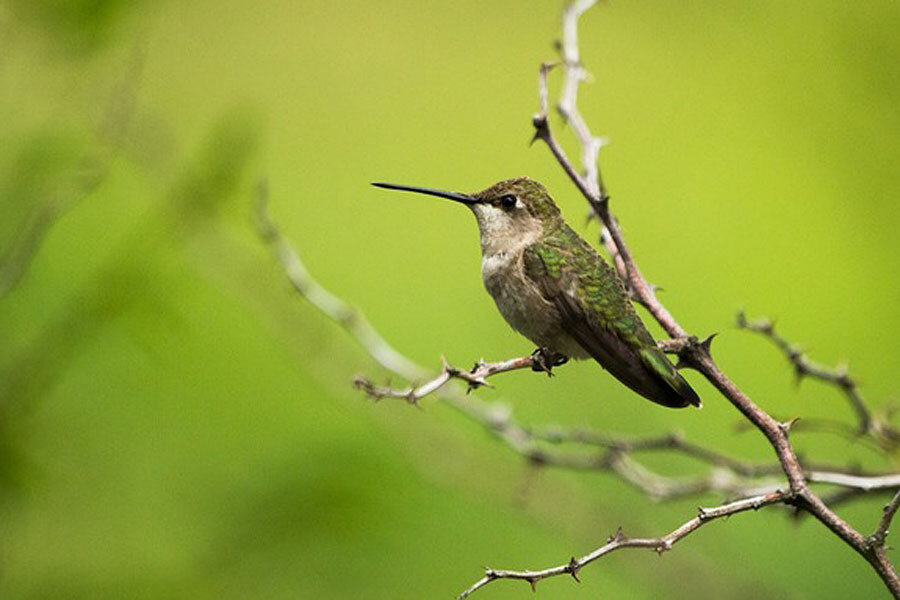Why hawks protect hummingbirds
Loading...
Tiny hummingbird nests, with their coffee-bean-size eggs, are a tempting treat for predators. But a new study finds that hummingbirds have evolved a clever approach to home security: They use hawks as guard dogs.
About 80 percent of the hummingbird nests built in the Chiricahua Mountains of Arizona are clustered near hawk nests, the researchers said. And location matters: When hummingbird nests are built near hawks, the nests have a daily survival rate of 31 percent. Outside of hawk territory, the daily survival rate drops to a mere 6 percent, one study found.
Harold Greeney, a biologist and the founder and director of the Yanayacu Biological Station Cosanga in Ecuador, and his colleagues first published that finding in The Wilson Journal of Ornithology in 2009. It wasn't the first time birds had been shown to nest near predators for protection, he told Live Science. [Gallery: Hummingbirds, Hawks & Predatory Jays]
"It wasn't anything particularly special until we went back and said, 'Well, we think that we showed that they do better there. The question now is, why?'" Greeney said.
The answer, it turns out, is that nesting hawks provide a "cone of safety" extending downward, Greeney and his colleagues report today (Sept. 4) in the journal Science Advances. Predatory jays that snatch hummingbird eggs avoid this cone to prevent becoming hawk food. (There are records of hawks eating hummingbirds in the wild, but the raptors prefer heartier snacks of large birds and rodents.)
"This is the first time anyone's figured out not just who all the players are, but exactly what it is about those players that's making [this] happen," Greeney said.
Stumbling on a discovery
Greeney and his team studied black-chinned hummingbirds (Archilochus alexandri) in the canyons and river valleys of the Chiricahua Mountains. Discovering that hummingbirds nest close to hawks was a matter of simply walking through the woods and making careful observations, Greeney said.
"I sort of stumbled on to this, and then I stumbled onto more and stumbled onto a little more," he said. [Images: Beautiful Hummingbirds of the World]
At first, it wasn't clear that the hummingbirds were seeking out hawk nests for safety, Greeney said — maybe both species were simply picking choice nesting spots and clustering together by accident. He recorded the heights and locations of hawk nests, hummingbird nests and the activity of predators, from squirrels to Mexican jays (Ampelocoma wollweberi).
He hoped to see that hummingbird nests within a certain radius of hawk nests would get a survival boost. But when he first plotted the data, he found no such benefit.
"I thought, ugh, back to square one," Greeney said.
Fortunately, though, Greeney had thought like a bird. He hadn't just recorded the horizontal location of nests and predators; he'd recorded their height, too.
And height turned out to be key. The hawks in the area are two particularly agile species, the Cooper's hawk (Accipiter cooperii) and the northern goshawk (Accipiter gentilis). These hawks hunt by perching quietly and waiting for prey to pass below. They then plummet down, dodging tree branches and bringing death from above.
Jays are aware of the danger these hawks pose, so they avoid passing under their perches. As a result, they forage higher up in the forest canopy near hawk roosts. Thus, building within 984 feet (300 meters) of a hawk nest yields a survival rate of 19 percent for hummingbird nests — not bad compared with 6 percent survival rate seen with nests farther away from hawks. But building within the 560-foot (170 meter) radius "cone of safety" boosts the survival rate up to 52 percent, Greeney and his team found.
Survival and security
It's typical for all birds that 60 percent to 70 percent don't make it out of the nest alive, Greeney said.
"When you're starting to get hammered at only 6 percent making it and you can find a behavior that bumps that up to 50 to 60 percent, that is huge," he said.
A mystery remains, though. Researchers aren't sure how the hummingbirds know to build near hawks. It's probably not a deliberate choice, Greeney said. Rather, hummingbirds probably look for spots where other hummingbird nests are successful. Or perhaps they learn by trial and error. Hummingbirds tend to build nests in the same spots year after year, and they abandon nesting sites where their nests are attacked, Greeney said.
Greeney now hopes to watch hummingbirds over time to see how females choose their nesting sites. It's difficult, though, because hummingbirds are so tiny. Researchers can put bands on their legs for later identification, but they can't read those bands from afar. And re-catching the birds disturbs their behavior. Greeney and his team have toyed with putting out feeders that would mark the birds' chest with paint for short-term tracking, but haven't gotten anything to work yet.
Follow Stephanie Pappas on Twitter and Google+. Follow us @livescience, Facebook & Google+. Original article onLive Science.
- Photos: Hummingbirds Slurp Up Tasty Nectar
- In Photos: Birds of Prey
- Of a Feather: Photos Reveal Stunning Birds of the Southwest
Copyright 2015 LiveScience, a Purch company. All rights reserved. This material may not be published, broadcast, rewritten or redistributed.







